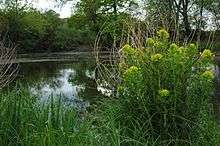Euphorbia palustris
| Euphorbia palustris | |
|---|---|
 | |
| Scientific classification | |
| Kingdom: | Plantae |
| (unranked): | Angiosperms |
| (unranked): | Eudicots |
| (unranked): | Rosids |
| Order: | Malpighiales |
| Family: | Euphorbiaceae |
| Genus: | Euphorbia |
| Species: | E. palustris |
| Binomial name | |
| Euphorbia palustris L. | |
| Synonyms | |
|
Tithymalus palustris (L.) Hill | |
Euphorbia palustris (marsh spurge or marsh euphorbia) is a species of flowering plant in the family Euphorbiaceae, native to marshland throughout much of mainland Europe and western Asia. It is an herbaceous perennial growing to 90 cm (35 in) tall and wide, with narrow leaves turning red and yellow in autumn, and persistent, bright acid yellow flower-heads (cyathia), 15 cm (6 in) across, in spring.[1]
It prefers permanently moist conditions in full sun, hence the common name "marsh spurge" and the Latin specific epithet palustris, "of marshland".[2] It is an ideal plant for gardening because it has a different color for almost all of the seasons. It has gained the Royal Horticultural Society's Award of Garden Merit.[3]
Like all euphorbias, all parts of the plant are toxic if ingested, and cut stems produce an irritant sticky sap.
References
| Wikimedia Commons has media related to Euphorbia palustris. |
- ↑ RHS A-Z encyclopedia of garden plants. United Kingdom: Dorling Kindersley. 2008. p. 1136. ISBN 1405332964.
- ↑ Harrison, Lorraine (2012). RHS Latin for gardeners. United Kingdom: Mitchell Beazley. p. 224. ISBN 9781845337315.
- ↑ "Euphorbia palustris AGM". Royal Horticultural Society. Retrieved 26 July 2013.